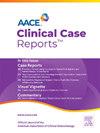Digital Twin Technology in Resolving Polycystic Ovary Syndrome and Improving Metabolic Health: A Comprehensive Case Study
IF 1.2
Q3 Medicine
引用次数: 0
Abstract
Background
Clinical manifestations of polycystic ovary syndrome (PCOS) are heterogeneous, with hallmarks including anovulation, androgen excess, and insulin resistance.
Case Report
A 38-year-old female with typical PCOS features presented with hypertension, obesity, and elevated fasting and postprandial insulin levels. She was enrolled in the Digital Twin (DT) platform, which uses artificial intelligence and Internet of Things to deliver personalized nutrition by predicting postprandial glucose responses and suggesting alternative foods with lower postprandial glucose response through a mobile app. After 360 days, significant improvements were observed. Weight decreased from 65.4 kg to 57.3 kg (−12.4%); body mass index lowered from 26.2 to 22.96 (−12.4%); Waist circumference reduced from 104 cm to 86.3 cm (−17.0%); clinic systolic blood pressure/diastolic blood pressure reduced from 144/93 to 102/80 mmHg (−29.17%/-13.98%); fasting insulin dropped from 27.6 to 15.5 μIU/mL (−43.8%); postprandial insulin decreased from 182.4 to 23.8 μIU/mL (−87.0%); Homeostatic Model Assessment of Insulin Resistance reduced from 6.47 to 3.48 (−46.2%); estimated glomerular filteration rate improved from 116 to 128 mL/min/1.73m2 (+10.3%); urine microalbumin creatinine ratio decreased from 596 to 73 mg/g (−87.8%). Ultrasound showed reduced ovarian volume and improved fatty liver infiltration, while computed tomography scan revealed significant reductions in epicardial (21.8%), pericardial (69.9%), and visceral fat (44.4%).
Discussion
This case shows the effective use of DT technology for managing PCOS, significantly improving weight, body mass index, insulin, blood pressure, and lipid profile. It supports the potential of artificial intelligence-driven, personalized interventions in chronic disease management.
Conclusion
This case highlights the potential of DT technology in managing PCOS, showing significant metabolic and reproductive improvements, suggesting promising future research directions.



数字孪生技术解决多囊卵巢综合征和改善代谢健康:一个全面的案例研究。
背景:多囊卵巢综合征(PCOS)的临床表现是异质性的,其特征包括无排卵、雄激素过量和胰岛素抵抗。病例报告:一名38岁女性,具有典型的多囊卵巢综合征特征,表现为高血压,肥胖,空腹和餐后胰岛素水平升高。她加入了Digital Twin (DT)平台,该平台利用人工智能和物联网,通过移动应用程序预测餐后葡萄糖反应,并建议替代餐后葡萄糖反应较低的食物,从而提供个性化营养。360天后,观察到明显的改善。体重由65.4 kg降至57.3 kg (-12.4%);体质指数由26.2降至22.96 (-12.4%);腰围由104公分减至86.3公分(-17.0%);临床收缩压/舒张压由144/93降至102/80 mmHg (-29.17%/-13.98%);空腹胰岛素由27.6 μIU/mL降至15.5 μIU/mL (-43.8%);餐后胰岛素由182.4 μIU/mL降至23.8 μIU/mL (-87.0%);胰岛素抵抗稳态模型评估从6.47降至3.48 (-46.2%);估计肾小球滤过率从116 mL/min/1.73m2提高到128 mL/min/1.73m2 (+10.3%);尿微量白蛋白肌酐比值由596 mg/g降至73 mg/g(-87.8%)。超声显示卵巢体积缩小,脂肪肝浸润改善,而计算机断层扫描显示心外膜(21.8%)、心包(69.9%)和内脏脂肪(44.4%)明显减少。讨论:本病例显示了DT技术在多囊卵巢综合征治疗中的有效应用,显著改善了体重、体重指数、胰岛素、血压和血脂。它支持人工智能驱动的慢性病管理个性化干预的潜力。结论:该病例突出了DT技术在PCOS治疗中的潜力,显示出显著的代谢和生殖改善,为未来的研究方向提供了前景。
本文章由计算机程序翻译,如有差异,请以英文原文为准。
求助全文
约1分钟内获得全文
求助全文
来源期刊

AACE Clinical Case Reports
Medicine-Endocrinology, Diabetes and Metabolism
CiteScore
2.30
自引率
0.00%
发文量
61
审稿时长
55 days
 求助内容:
求助内容: 应助结果提醒方式:
应助结果提醒方式:


